Seeing Things: May 2010 Archives
Ballet Diary No. 3: American Ballet Theatre: Opening-night gala; La Bayadère (ABT's season runs through July 10 at the Metropolitan Opera House, Lincoln Center); Unrelated Solos / Baryshnikov Arts Center / May 19-22; New York City Ballet: Benjamin Millepied (NYCB's season runs through June 27 at the David H. Koch Theater, Lincoln Center)
Note: This is No. 3 in the series "Ballet Diary," commenting on the spring seasons of New York City Ballet and American Ballet Theatre, along with related performances. To read the previous pieces in the series, click here: No. 1; No. 2. The completed "Ballet Diary" series will comprise nine essays.
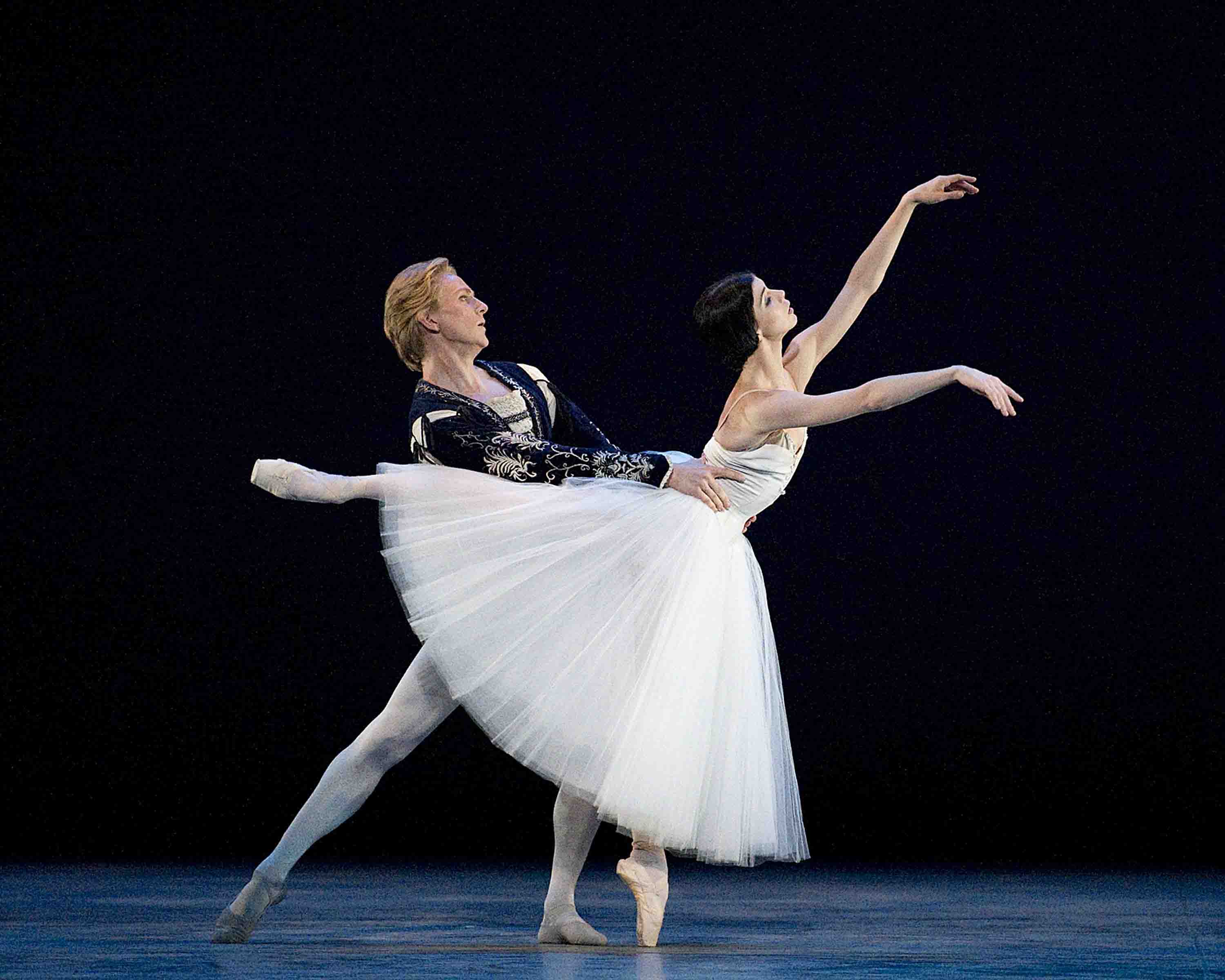
Natalia Osipova, partnered by David Hallberg, in Giselle, at ABT's opening-night gala
Photo: Gene Schiavone
American Ballet Theatre's opening night gala, May 17 at New York's Metropolitan Opera House, served as a tasting menu. The program comprised a selection of excerpts--almost all from ballets known to please. It gave every star at the top of the company's roster a chance to shine, and showed off the corps de ballet not just once but twice.
The program was too long, of course, and the myriad excerpts that made it so were almost all too short to give the audience more than a glimpse of the fascination dancing compels when it's allowed to be expansive. But there were several lovely--even glorious--moments. True, a few items misfired but, hey, it's ABT's 70th anniversary and it would be rude to rain on its party.
The preliminaries included a walk-on, in gorgeous mufti, of seven artists who have been essential to the company's history: Lupe Serrano, Martine van Hamel, Nina Ananiashvili, Mikhail Baryshnikov, Alessandra Ferri, Natalia Makarova, and Frederic Franklin. Then there was speechifying by ABT's artistic director, Kevin McKenzie, Caroline Kennedy, Blaine Trump, and the evening's honoree, David H. Koch. Koch donates generously to big-time cultural institutions like ABT. (He made a major contribution to the renovation of the New York State Theater--the New York City Ballet's home--and got the place renamed for him.) Here he reiterated his promise of substantial support for a lavish Nutcracker that will premiere at BAM this winter and make the company lots of money. Said to be the 10th richest man in America, he came across, disarmingly, as just an ordinary guy.
Then came the dancing. The event on the program was the guest appearance of the Bolshoi Ballet's young phenomenon, Natalia Osipova, partnered by ABT's immaculate classicist, David Hallberg, in an excerpt from Act II of Giselle. Osipova's rendition of Giselle as a lyrical wraith, returned from the dead to dance for one last time with the feckless lover who understands true love too late, was refined seemingly beyond human limits. In the famous adagio, her interpretation was pristine and spooky; then, when the tempo accelerated, it became feathery, weightless. The overall effect wasn't tragic, since the performance seemed more the result of endless coaching rather than instinct, but it was thrilling none the less.
Another development that may be the result of intense coaching is Michele Wiles's adding a dimension of artistry to her familiar technical prowess. Performing the Rose Adagio from The Sleeping Beauty--a test of balance and timing that gives the most assured ballerinas the quivers--she managed to cloak the challenges in the springtime softness and pleasure of a princess meeting her first suitors on her 16th birthday. Yes, this burgeoning still looks learned rather than instinctive but, for Wiles, it's an essential step in the right direction.
The Act III pas de deux from Don Quixote supplied the gala's requisite dose of bravura at its most flamboyant. Gillian Murphy and Ethan Stiefel, both certified virtuosi, were in fine form, Murphy tackling the notorious 32 fouettés by making many of the turns multiple ones, and generally applying modesty and wit to her assignment. Stiefel was a shade too show-offy, embellishing the completion of his feats with hand flicks à la russe that are blatant signals for applause. Yet one forgives him almost anything witnessing his near-miraculous recovery from an injury that might have ending his dancing career.
Frederick Ashton, the most poetic of Britain's choreographers, was represented by two ballets--the haunting Thaïs pas de deux and an excerpt from Birthday Offering, a survey, both aristocratic and graceful, of the choreographer's neo-classic mode, which gave the Royal Ballet its profile. Needless to say, ABT's dancers haven't been bred to dance Ashton, but their efforts to grasp the nature of his style are sufficient to reveal both the beauties of the choreography and the dance-making intelligence that pervades it.
Nearly all of the excerpts on the gala program will, as if via the magic wand of Cinderella's godmother, turn into full ballets in the course of ABT's season, which continues through July 10.
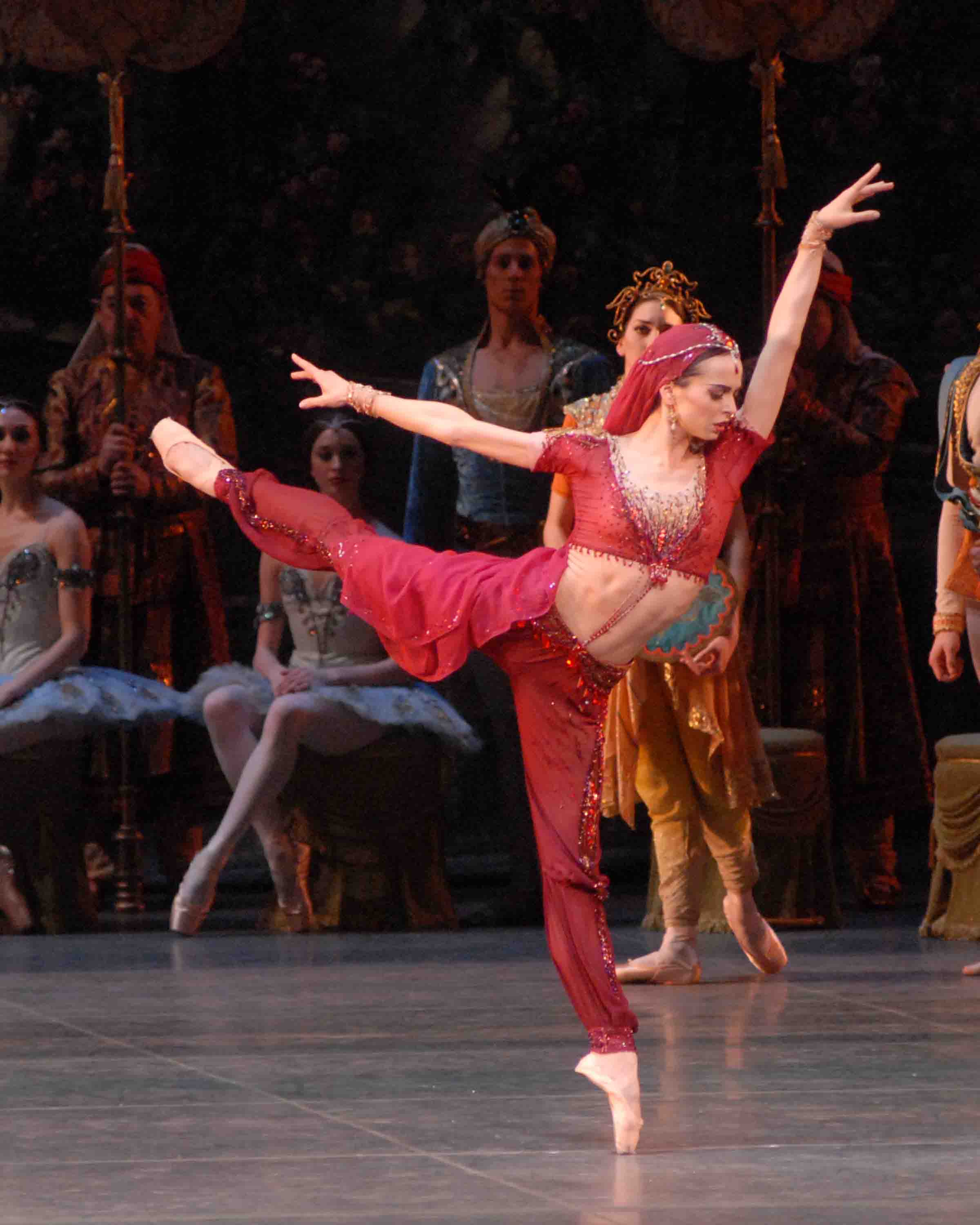
Diana Vishneva as Nikiya in La Bayadère
Photo: MIRA
How many times in close succession can you enjoy seeing La Bayadère? ABT launched its weeks of repertory with eight performances in a row of Marius Petipa's Russo-Indian creation--full of hokey melodrama and ersatz local color, yet intermittently divine. Indeed, on two days, thanks to the magic of matinees, you could see it twice.
This is typical of ABT's current programming style. Many followers of the company, including me, prefer the old repertory system, in which programs of shorter ballets were changed daily and the components were not forced to be related by theme. Truth to tell, one Bayadère a season is enough for me, though I could look at the ballet's ineffable "Kingdom of the Shades" scene frequently, to satisfy my craving for the sublime. Last week, faithful to professional duty, I saw the full ballet twice, first with Diana Vishneva, Gillian Murphy, and Marcelo Gomes, respectively, in the leading roles of Nikiya (the pure, put-upon girl who is dead for half the ballet), Gamzatti, (a jealous poisoner, perhaps with some cause), and Solor (like many a man, of two minds when it comes to a major choice). The next day I saw the Julie Kent-Hee Seo-Jose Manuel Carreño cast.
Natalia Makarova supervised the production she had staged first in 1980, revivifying it with close attention to both the purity of classical technique and detailed dramatic motivation. If a few of her decisions are questionable--such as the achingly slow tempi for adagio work, a conceit of Russian ballerinas who want to look ineffable--most justify the 19th-century ballet's claim to ongoing life in the 21st.
Vishneva made a terrific Nikiya, her steely technique operating under the guise of melting vulnerability and the notion that a heart can remain faithful even in the next world. She's one of the most accomplished actor-dancers around. If the multi-faceted passions she portrays seem synthetic at times--their lack of spontaneity is the giveaway--she often persuades even the most recalcitrant viewer to succumb to her spell. Kent, granted, trumps Vishneva in pathos--her willowy body and fragile beauty make her look born for the pathetic mode--but some of Bayadère's physical challenges are now beyond her.
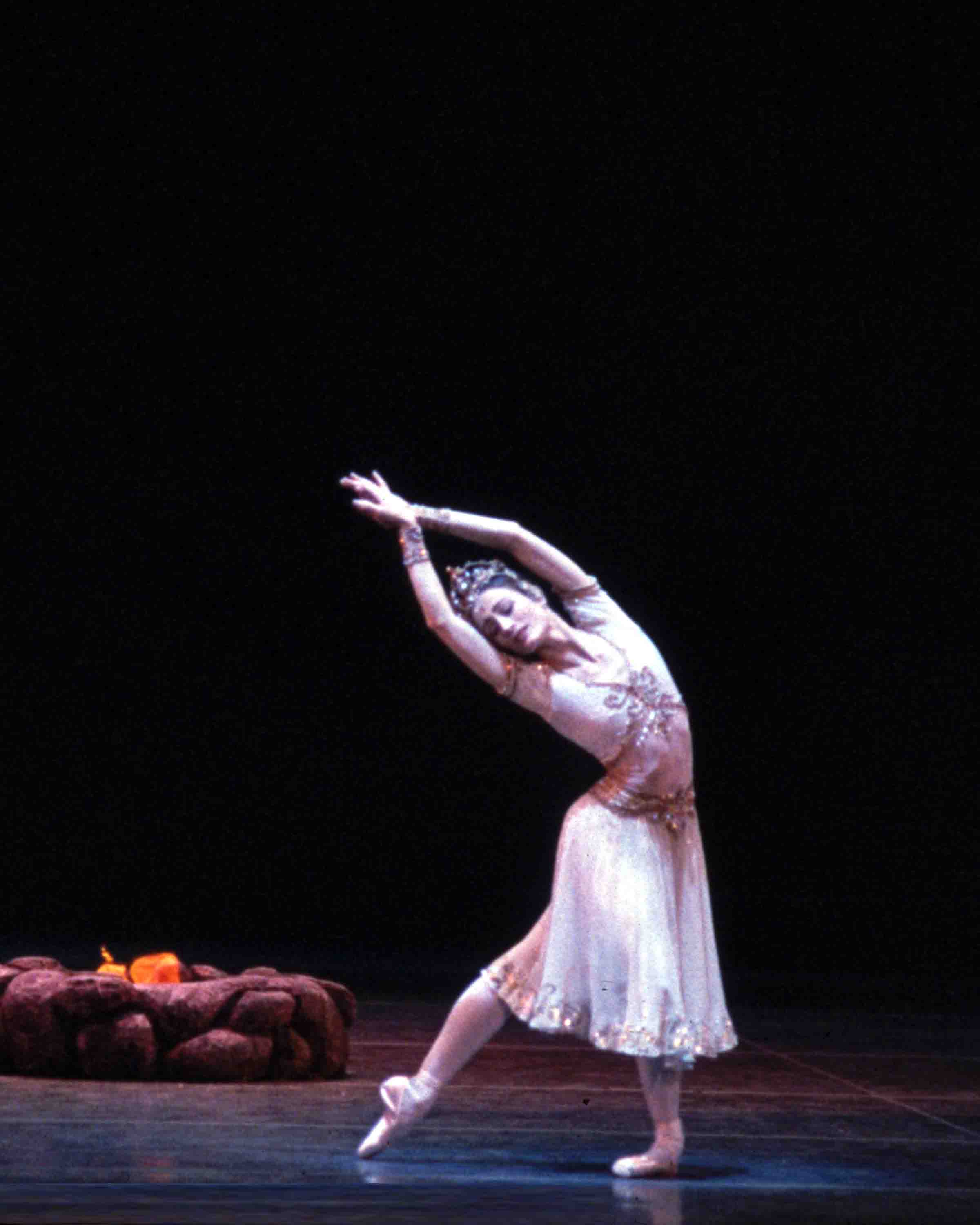
Julie Kent as Nikiya in La Bayadère
Photo: MIRA
Murphy, who has technical confidence to spare and an uncanny resemblance onstage to Bette Davis, was just right for the proud, icy hearted Gamzatti, a rajah's daughter to whom no one has ever before said no. When offers of jewels and the haughty assertion of rank's privileges fail to persuade Nikiya to relinquish her claim to Solor's love, what's a handsome, filthy rich, singularly self-involved young woman to do but send her rival a bouquet in a basket that happens to harbor a poisonous snake?
The alternate Gamzatti, Hee Seo, has risen so quickly at ABT that she's still listed among the corps de ballet. Her technique is impressive and she has the magnetic presence of a star. Yet thus far, in the realm of artistry, she remains an enigma. You have no idea of who or what she is as a dancer. As for what she might become, time will tell. Just now she smiles and smiles, presenting herself as a blossom worth plucking.
Both Gomes and Carreño surpassed themselves as Solor, their several solos making their customary bravura feats exceptionally clear and precise, rather than (as such astonishing exploits usually are) undertaken on a wing and a prayer, with a wild surge of energy. Both men moved with velvety texture--Gomes with the gravity that so becomes him, Carreño with his trademark ingratiating sweetness--towards his partner and, I'd guess, in homage to the joy of dancing. Gomes had the advantage over Carreño in that he was working with the more impressive co-stars, and the performance I saw of the Gomes-Vishneva-Murphy triad was nothing short of spectacular, one artist taking fire from another.
The female corps de ballet of the "Kingdom of the Shades" scene was better than ever; the choreography's demand for impeccable adagio dancing in unison seemed to have the 24 women breathing as one. As it's presently performed, this passage is a perfect argument for the idea that an ensemble can be a main character in a ballet.
The High Brahmin, the kind of secondary role so easily treated as a cipher, was given persuasive and individual meaning by Victor Barbee (Vishneva cast) and Roman Zhurbin (Kent cast). In each portrayal you saw, phrase by phrase, the conflict of a religious dignitary, glorying in his power, who finds himself overcome by lust for the most exquisite vestal virgin in his temple. The fact that Nikiya already has a boyfriend, Solor, whom she will lead to Paradise --when all is said and done and everyone perishes in the destruction of the temple--is one of the several things making Bayadère seem silly, but never mind.
Mikhail Baryshnikov was the leading dancer--isn't that a given whenever he appears?--in Unrelated Solos, May 19-22, part of the inaugural season of the Jerome Robbins Theater at the Baryshnikov Arts Center. The new performance space is small, austere, and glum. Without distinction of design, it serves its purpose in a workaday fashion.
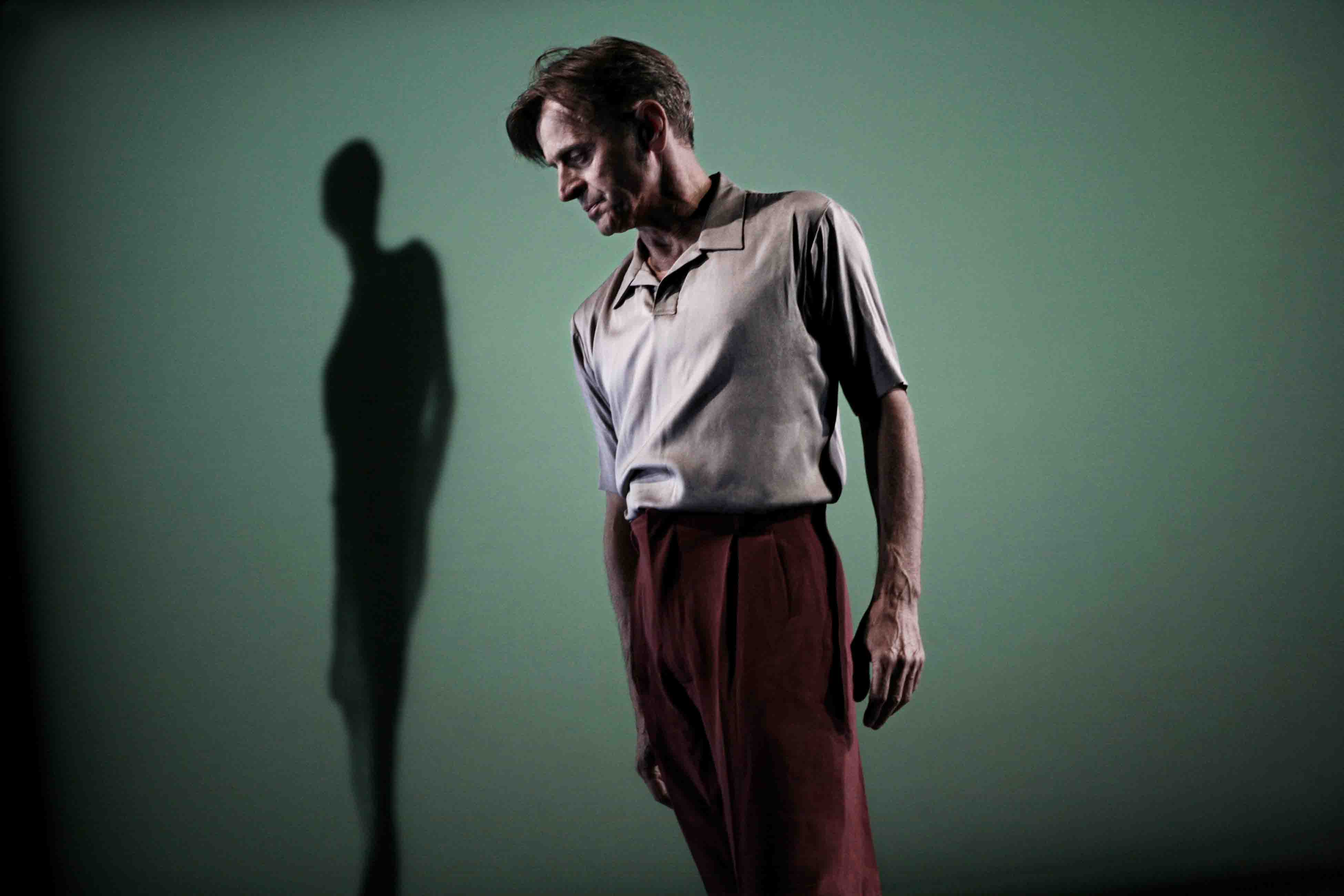
Mikhail Baryshnikov in Benjamin Millepied's Years later
Photo: Julieta Cervantes
The key pieces on the program were Benjamin Millepied's Years later (to music by Philip Glass) and Alexei Ratmansky's Valse-Fantasie (to the fervid Glinka music of that name). The two choreographers offered strikingly disparate views of the extraordinarily gifted dancer whose athletic prime ended at least two decades ago and who has yet found myriad ways of carrying on.
The Millepied solo depends on film footage of the 17-year-old Baryshnikov as a student at the Vaganova Academy, from which he'd be launched into the Kirov Ballet. Captured in grainy black and white, he's a prodigy with an angelic face, performing feats of classical perfection in a barren studio. The astonishing dancing image is projected on the backdrop of Years later for today's Baryshnikov to interact with. Even when Baryshnikov is not being challenged by his youthful self, Millepied's choreography manages to make the 62-year-old artist appear stiff and desiccated. The fiery energy seems quenched; the elasticity, vanished; the flow of movement through a supple body, blocked. Basically, Millepied's piece tells us, "Yesterday wins."
Ratmansky, on the other hand, draws on everything Baryshnikov can do--can be today--obliterating a veteran spectator's sense of what has been lost in favor of a lyrical and luminous now. The little ballet opens with a recorded voice telling the tale of Glinka's thwarted infatuation with a young woman: At the time, it broke his heart, but some years later, when he met her again, he had no feeling for her at all.
The story is choreographed as a rapid succession of segments that, like fireworks, illuminate the space, then just as swiftly fade from view. Ratmansky uses the gifts that Baryshnikov still possesses in good measure: harmony of line, precision of placement, acumen in mime, a sense of humor, and undiminished charm. Most important, the choreographer finds a way to restore to Baryshnikov the flow that is pretty much essential to dancing. As Baryshnikov cruises through space, he might be an emblem of freedom and joy.
The choreography is well-nigh Chekhovian, proposing that the past floods through you at moments in the present, when you can have a good look at it armed with the experience and wisdom of your maturity and laugh at it, scorn it, or refuse it--but never forget it.
Ratmansky gives us a man--an artist--who is fully alive in the
present.
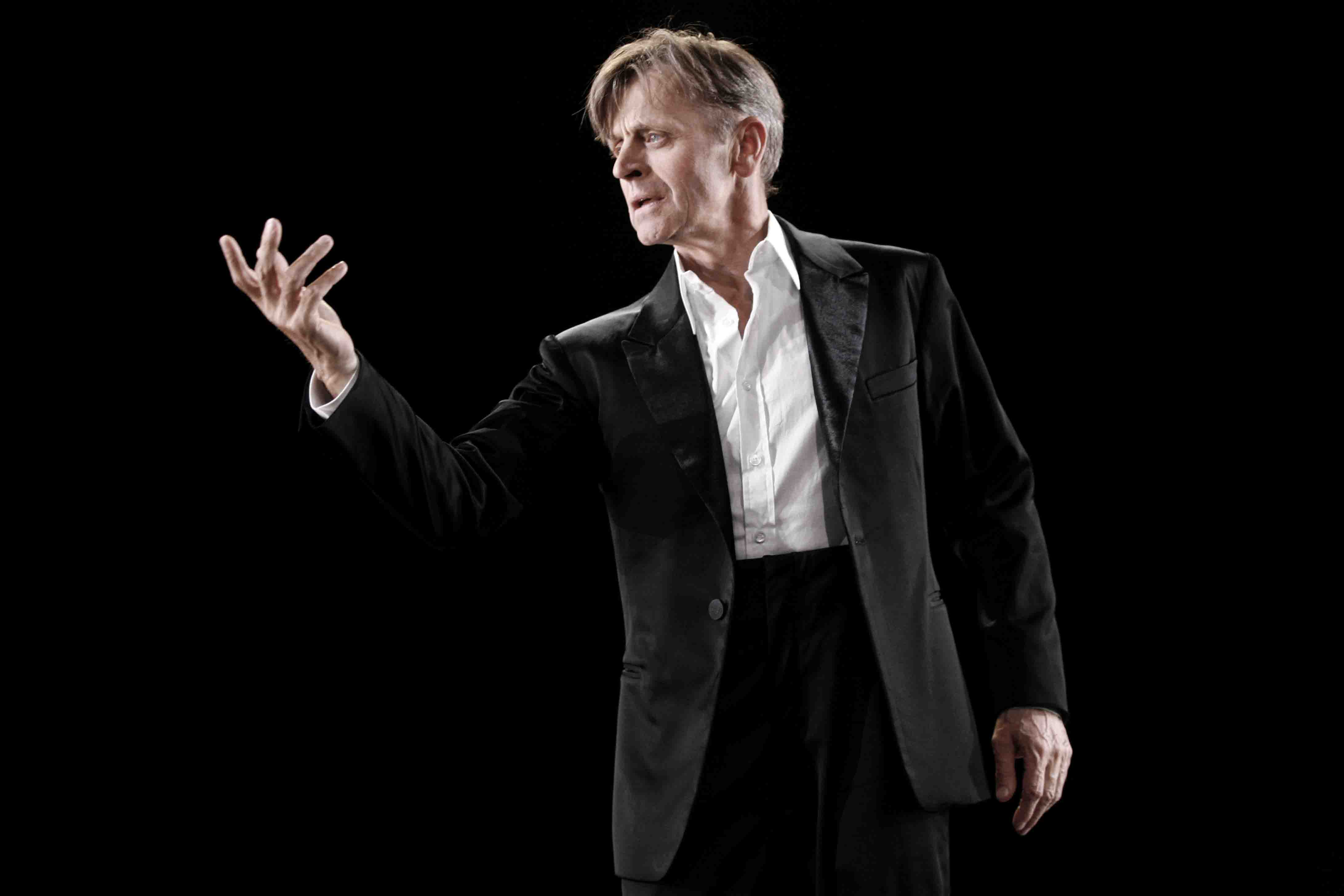
Mikhail Baryshnikov in Alexei Ratmansky's Valse-Fantasie
Photo: Julieta Cervantes
The program's six solos were indeed unrelated, as promised. The veteran postmodernist Steve Paxton appeared in a seemingly endless string of restricted, even crippled, moves that gradually ensnared one's attention and eventually ignited one's imagination. Choreographed by Paxton and called The Beast, the piece made me think of Shakespeare's Caliban--a creature with just enough sentience to feel trapped in his limitations. David Neumann performed two of his solos; reminiscent of Daniel Nagrin's character studies, they sorely lacked Nagrin's finesse.
For a finale Baryshnikov danced a "solo" that recruited three members of the audience--Susan Marshall's For You. It is, perhaps, an exploration of a star performer's relationship to his spectators. But who knows? Marshall's a subtle and canny one and the piece was billed as a work in progress.
When I wrote briefly about Benjamin Millepied's Why am I not where you are--one of the seven new ballets commissioned for New York City Ballet's "Architecture of Dance" festival, I said--having seen its premiere under the hectic circumstances of the company's opening night gala--that I'd comment further on it. I've seen it a second time now, but can't bring myself to write about it. I think I'm doomed not to "get" Millepied's choreography. Although I've tried assiduously over the years, I simply can't discover what there is to admire, let alone love, about it.
Granted, Millepied uses the classical vocabulary (and one must be grateful for that in our tradition-scorning era), but he fails to achieve anything organic or even adept in his deployment of bodies in space, let alone anything that stirs the heart or soul. All I see is arid, often awkward, calculation. Nevertheless, he has carved out an impressive career for himself. Ballet fans have cautiously begun to name him along with the best of his generation, Ratmansky and Wheeldon.
© 2010 Tobi Tobias
Ballet Diary No. 2: Introduction to the "Ballet Diary" series; New York City Ballet: Wayne McGregor's Outlier; Alexei Ratmansky's Namouna, A Grand Divertissement / David H. Koch Theater, Lincoln Center, NYC / NYCB season: April 29 - June 27
Note: This is No. 2 in the series "Ballet Diary," commenting on the spring seasons of New York City Ballet and American Ballet Theatre, along with related performances. To read the previous piece in the series, click here: No. 1. The completed "Ballet Diary" series will comprise nine essays.
Outlier, commissioned from the British Wayne McGregor by New York City Ballet for its "Architecture of Dance" festival and set to Thomas Adès's Concerto for Violin--Concentric Paths, had its world premiere May 14 at Lincoln Center's David H. Koch Theater. I can't say that the earth moved.
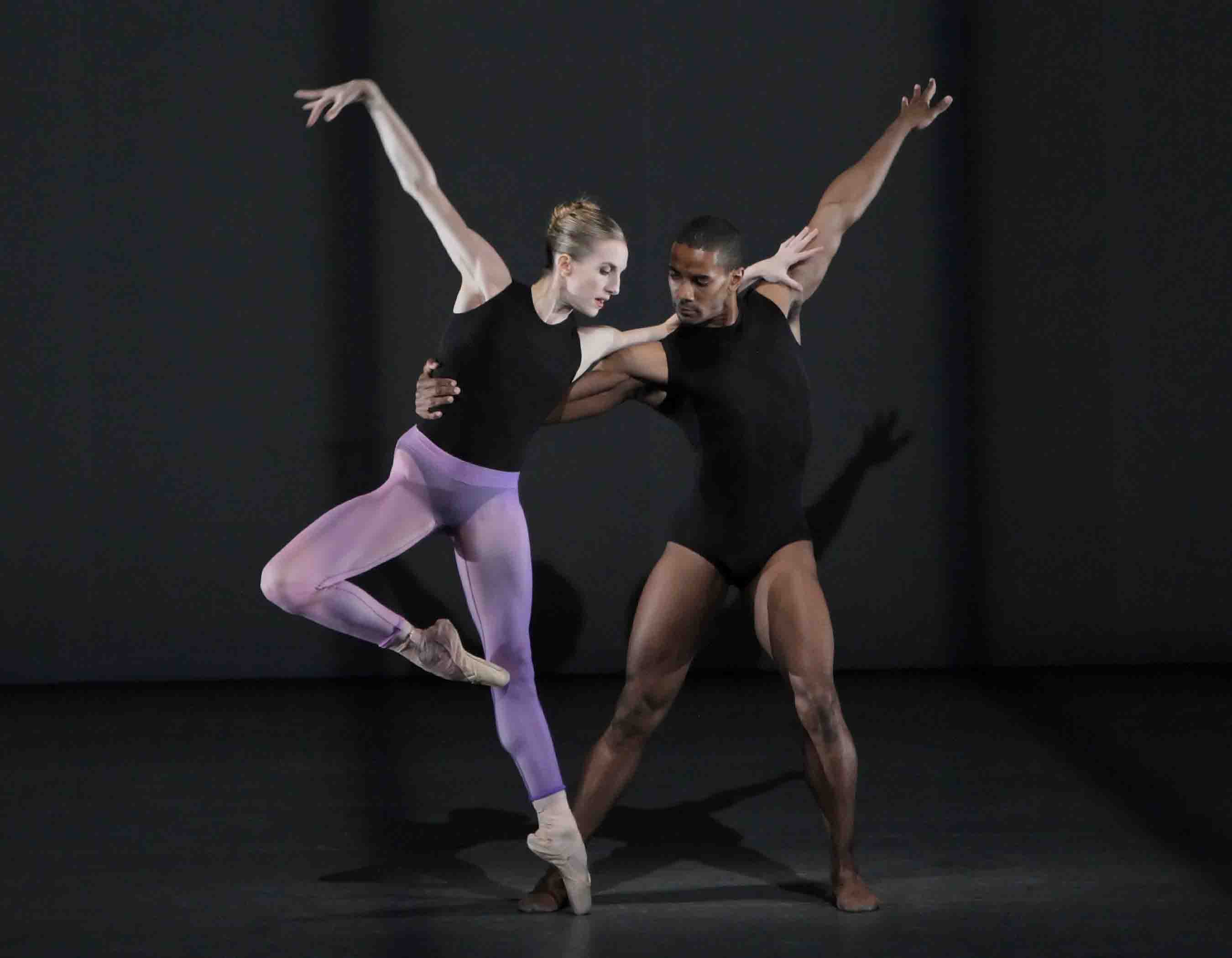
Wendy Whelan and Craig Hall in Wayne McGregor's Outlier, one of the seven new works in New York City Ballet's "Architecture of Dance" festival
Photo: Paul Kolnik
McGregor's work is new to New York but his reputation has preceded him. Two years ago, though he was known as an ostensibly cutting-edge dance maker, he was appointed resident choreographer of the London-based Royal Ballet, much to the consternation of the company's fans accustomed to a repertory dominated by traditional classical ballet.
Dance aficionados began talking about McGregor as a major player in the avant-garde when he founded his own small troupe, Wayne McGregor | Random Dance, back in 1992. (Notice the bracing vertical line instead of the conventional leaning slash. Talk about eloquence in punctuation!) Eventually the group became the resident company of Sadler's Wells, the London half of an ambitious producing organization; New York's City Center is its Stateside partner.
Random Dance is purportedly a poster company for "making it new." Its repertory is often set to sound scores that are not your grandmother's music. Its movement typically ranges from the fractured (think Jorma Elo) to seemingly boneless fluidity (I can't help thinking of this as "the worm effect"). Frequently it reverts to a base of classical ballet technique commanded in an underpowered way by the group's otherwise attractive dancers. The choreography revels in co-opting the ever-burgeoning paraphernalia being developed in the fields of science and communication and is naturally multi-media inclined. Of course this aesthetic influences McGregor's work for some of the world's topnotch exponents of classicism.
Actually, from the videotapes I've seen, none of McGregor's choreography looks very new to me--not new in the sense of the early-through-middle-period Martha Graham and Twyla Tharp.
Outlier is a suave piece of work. It is neither dumb nor vulgar; this, I reckon, is a plus. The reticent backdrops (by McGregor and Lucy Carter, who also designed the lighting) and the costumes by Moritz Junge (essentially practice clothes in muted colors, set off here and there by a bare male torso or uncovered legs) almost shout "good taste." The Adès score is a brainy post-modern affair. (An explication of it, handed out to the press, is written in a highfalutin style that would have made E.B. White chuckle.) The music itself requires a close concentration well-nigh impossible to give it while focusing on the choreography it accompanies--at least on one's first experience of the two elements.
The choreography capitalizes on the extreme elasticity that is a by-product of a classical dancer's training, but surely not the chief goal of that training. To my mind, the arduous, nearly decade-long process of preparing a carefully selected aspirant for a professional life in ballet aims to teach him or her to move with clarity while maintaining rhythmic phrasing, physical flow, and expressive eloquence. Pliability (an element essential to gymnasts and contortionists), is important but it doesn't lie at the center of the art of dancing.
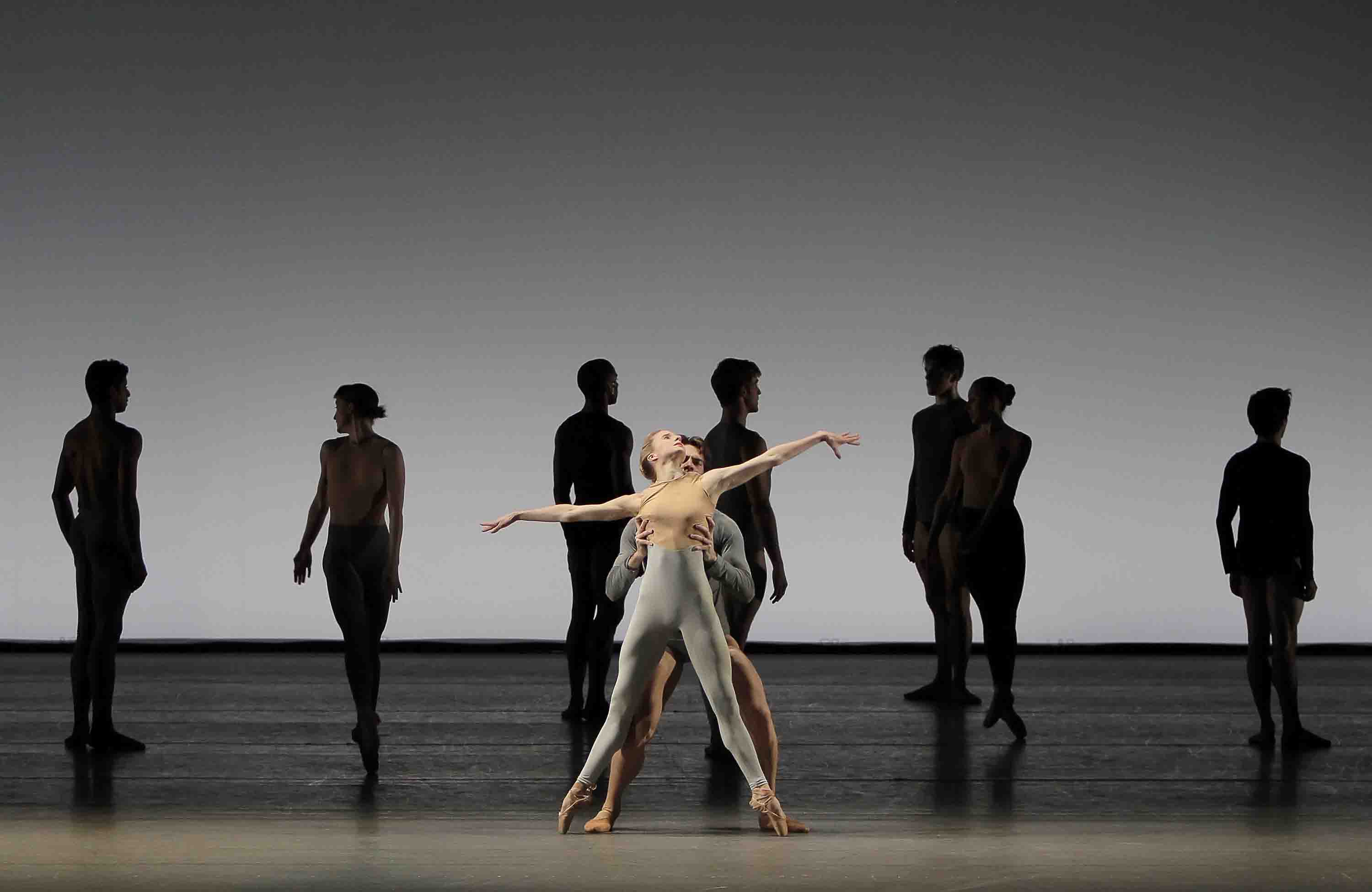
Sterling Hyltin and Gonzalo Garcia in Wayne McGregor's Outlier, one of the seven new works in New York City Ballet's "Architecture of Dance" festival
Photo: Paul Kolnik
The initial duet in Outlier reveals McGregor's limitations straight off. A man prowls around a woman, then co-opts her as his partner. First he gently explores her flexibility, sculpting her body into extreme shapes and treacherous positions. He's a Pygmalion fixated on his subject's ball bearing joints. She doesn't seem to have any say in the matter, even when he briefly gets a touch rough-handed with her; her role is to agree, to submit. More dismaying than this possible violation of pc behavior is the fact that there's no physical logic to the movement sequences. One phrase glides smoothly into the next, but an ensuing move never feels like the inevitable consequence of the preceding one.
Later, a sextet makes various connections, with all of the participants appearing to be in a state of anomie, subservient to their fate. In a quartet for three men and a woman, one of the men has a push-me pull-you duet with the woman, followed immediately by a more balletically conventional one with one of his buddies. On the whole, though, the presence of academic steps in Outlier is sparse, while the vocabulary used is gravely limited.
The piece was handsomely executed by its eleven dancers, Craig Hall, Wendy Whelan, and Tiler Peck being exceptional. These three were so in control of the strange movement, they could make it look almost natural--as if it spilled directly from their guts. And still it failed to offer any meaning.
Of the four new ballets unveiled so far in New York City Ballet's "Architecture of Dance" festival, the one to get excited about is Alexei Ratmansky's Namouna, A Grand Divertissement. On its first showing I wrote about it briefly in Ballet Diary No. 1. Having seen it again, twice, since its premiere, I want to say more.
Born in Russia and trained in the school of Moscow's Bolshoi Ballet, Ratmansky failed to make it into the parent company and danced with a series of geographically disparate troupes, all the while developing his gifts as a choreographer. Eventually--talk about irony!--the Bolshoi called him home to become its artistic director. No happy ending--yet. He found that the administrative work of the job left him insufficient time in which to choreograph and tendered his resignation. He then flirted with New York City Ballet (for which he'd already made a pair of well-received pieces) as a possible replacement for Christopher Wheeldon, who was giving up his position as the company's resident choreographer to form his own group (which he has since abandoned). When the City Ballet opportunity went up in smoke, Ratmansky became--as quick as you can say "about face"--American Ballet Theatre's artist in residence. He made certain that his arrangement with ABT allowed him to choreograph elsewhere as well--like Wheeldon, he's in demand worldwide--and so City Ballet has his wonderful Namouna.
The music for Namouna, by the French neo-Romantic composer Édouard Lalo, was originally created for a ballet by Lucien Petipa (brother of the more celebrated Marius) that had its premiere at the Paris Opera in 1882. Neither the ballet nor its score--accused of being "too symphonic"--caught the public's fancy, and the production disappeared from the repertory after a mere 15 performances. Confident that he had composed something of value, Lalo repurposed his music into two orchestral suites and other pieces for the concert stage. For his ballet, Ratmansky marshaled 16 of the numbers that had been recorded by David Robertson and the Orchestra of Monte Carlo on a CD of these pieces.
The music is a mélange of myriad perfumes, by turns exotic, nostalgic, dramatic, sensuous, playful, and lamenting. It is full of rhythmic vitality, grace, and charm. And, despite what the Parisian audience thought in the 1880s, the orchestration is lovely.
The original ballet for which the Namouna score was created was apparently a kind of Le Corsaire affair (possibly tinged with a musky Arabian Nights atmosphere) and boasted a plot that would be considered outlandish today. Ratmansky jettisoned the idea of narrative but continually hints at stories through the "characters" he's created.
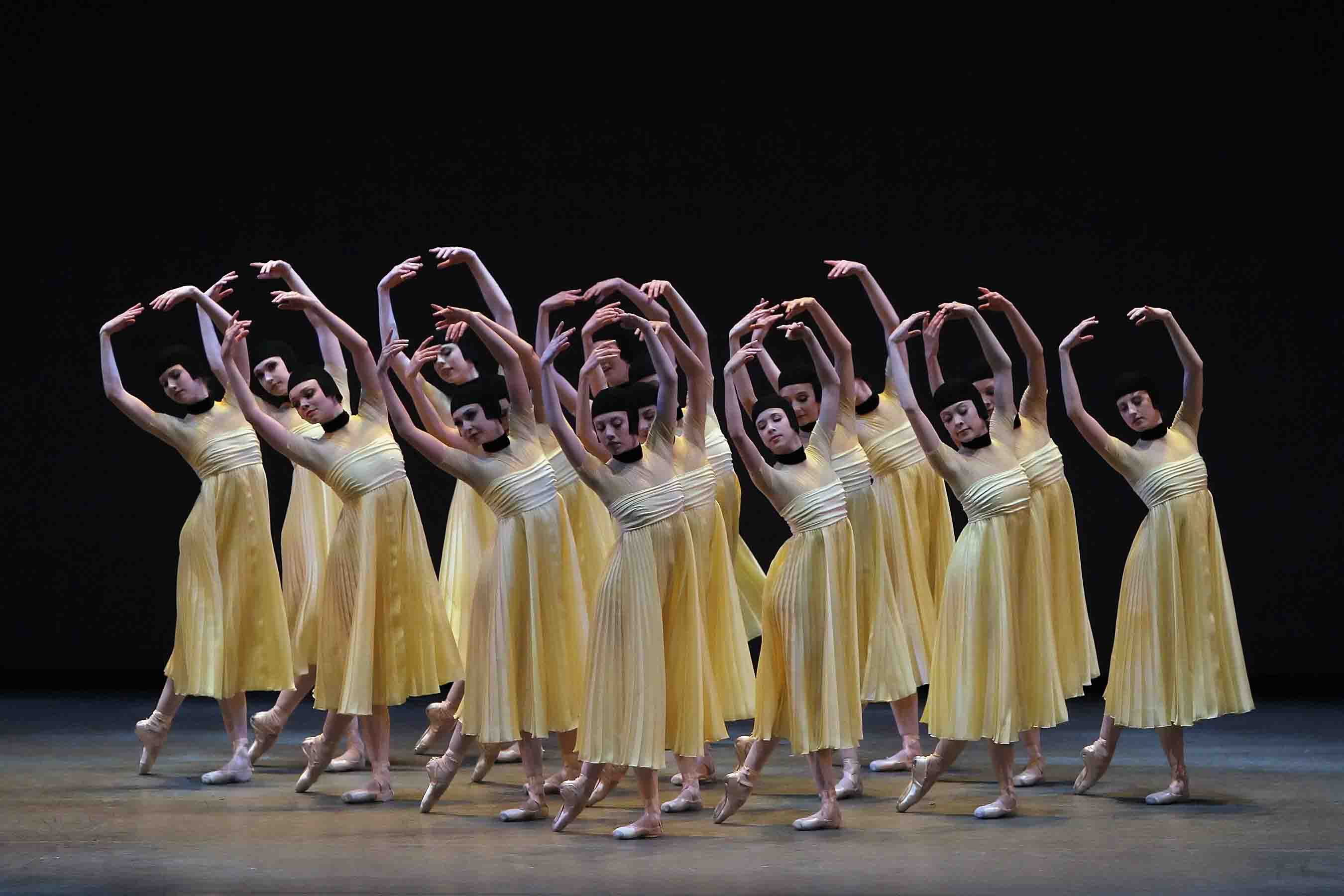
The women in yellow, from Alexei Ratmansky's Namouna, A Grand Divertissement, one of the seven new works in New York City Ballet's "Architecture of Dance" festival
Photo: Paul Kolnik
The ballet opens with the entrance of an ensemble of 16 seemingly identical women, dressed in gowns of chrome yellow falling below the calf. They're capped with pitch-black wigs severely styled in the manner of Louise Brooks's iconic bob; black chokers circle their necks. Their arms are flung backward, giving them a heroic--and faintly menacing--air. At first they step slowly and deliberately in a straight line, but then the line swirls into a circle, next into a pair concentric circles, and soon Ratmansky assigns them, one at a time, increasingly aberrant actions that define individuals within this sisterhood of clones.
Our Hero (Robert Fairchild) is a fresh-faced young man in a white sailor's suit, who, throughout his several solos, maintains a relaxed, modest air while delivering amazing technical feats. Gradually we come to realize that he's searching for Ms. Right, a role for which three women "audition." They are Jenifer Ringer (in French blue), at once sweet and, dancing a long solo with a lit cigarette, sassy; Sara Mearns (in midnight blue), who recalls Suzanne Farrell in the amplitude, suppleness, and daring of her dancing; and Wendy Whelan (in the palest ice blue imaginable), who counters Mearns's primal energy with her reticence and delicacy. Whelan wins out (though she never competes) and so gets to perform the tender closing pas de deux with Fairchild. Highlighting this duet is a sequence of remarkable lifts, in which she appears both weightless and luminous, as fragile as spun glass. The curtain falls on the pair sealing their bond with a prolonged Hollywood kiss.
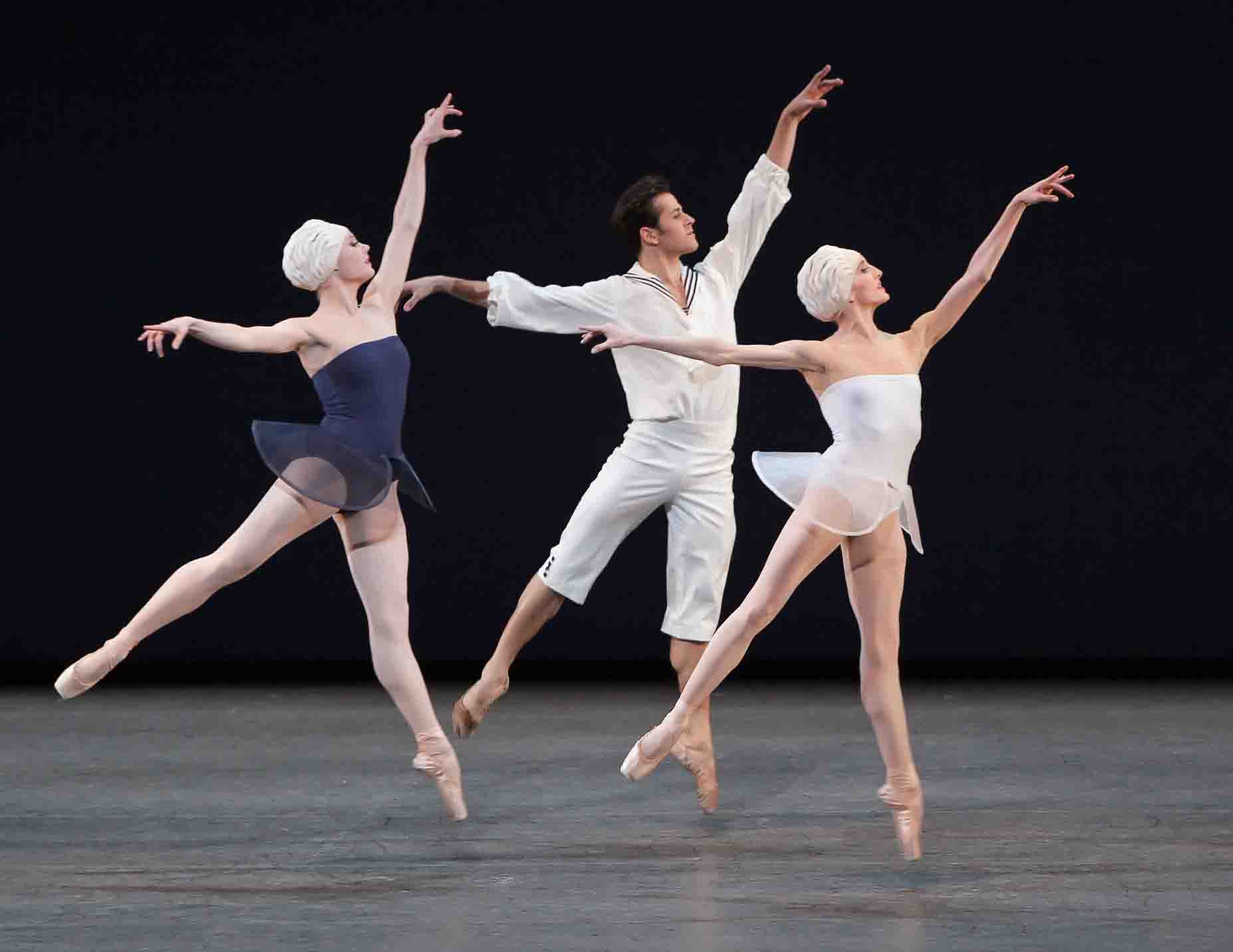
Sara Mearns, Robert Fairchild, and Wendy Whelan in Alexei Ratmansky's Namouna, A Grand Divertissement, one of the seven new works in New York City Ballet's "Architecture of Dance" festival
Photo: Paul Kolnik
One step lower in importance, yet indispensable to the proceedings, is a trio of diminutive dancers in bronze: Daniel Ulbricht--of the bulging muscles that allow his spectacular tours de force, yet as buoyant as a helium balloon--and a pair of piquant women, Megan Fairchild and Abi Stafford. Presumably, the job of these three is to provide variety through steps particularly suited to their body type and to show us the cunning ways in which a trio, and only a trio, can be manipulated.
At one point Ulbricht repeatedly picks up one of his playmates and shifts her position from one side of him to the other, then does the same for the second petite miss. Although he repeats this action several times, nothing really changes. (This amusing bit of business points to a significant irony: dance is like its sister arts in which, as Auden tells us, "Poetry makes nothing happen.") Finally Ulbricht carries his erstwhile partners into the wings, one in each burly arm. It's possible to think of all three figures as life-size wind-up toys or perhaps a set of mechanical dolls created by the ingenious Dr. Coppelius.
The women in yellow who opened the ballet and have important choral work in its course also double (with a speedy costume change) as a chorus of naiads with a complaint that chronically reduces them to tears: none of them becomes Our Hero's chosen one; none of them stands a chance. In blue, then, the female ensemble can express human emotion. In their yellow guise, however, the women are simply enigmatic and powerful--messengers of fate, perhaps. In one of their most striking and eerie passages, they assemble as if rimming a large semi-circle, small brass cymbals in their hands. At intervals, they strike these together to produce a tiny, even-paced, metallic ringing. Now and then, they hold the glinting cymbals to their eyes and the musical instruments seem to morph into cameras or opera glasses--both tools designed to "steal" images. As always, their faces are completely devoid of expression.
Last, though hardly least, is an octet of men who might be, guessing from their costumes, members of a motorcycle gang. They are chivalrously present whenever a bunch of feisty guys is needed--rescuing a maiden from drowning, for instance, or partnering the yellow gals in a spate of deep-rooted folk dancing.
Shunning plot and specifically identified characters, Ratmansky was hardly likely to pin down the setting of his ballet, but it's surely somewhere by the sea, that realm of fanciful dreams. At times, the action even seems to take place underwater; those women in blue might be mermaids. And the sea might well be the Mediterranean; Lalo wrote his score for a ballet set on Corfu and, some 130 years later, isles-of-Greece hints survive in Ratmansky's choreography.
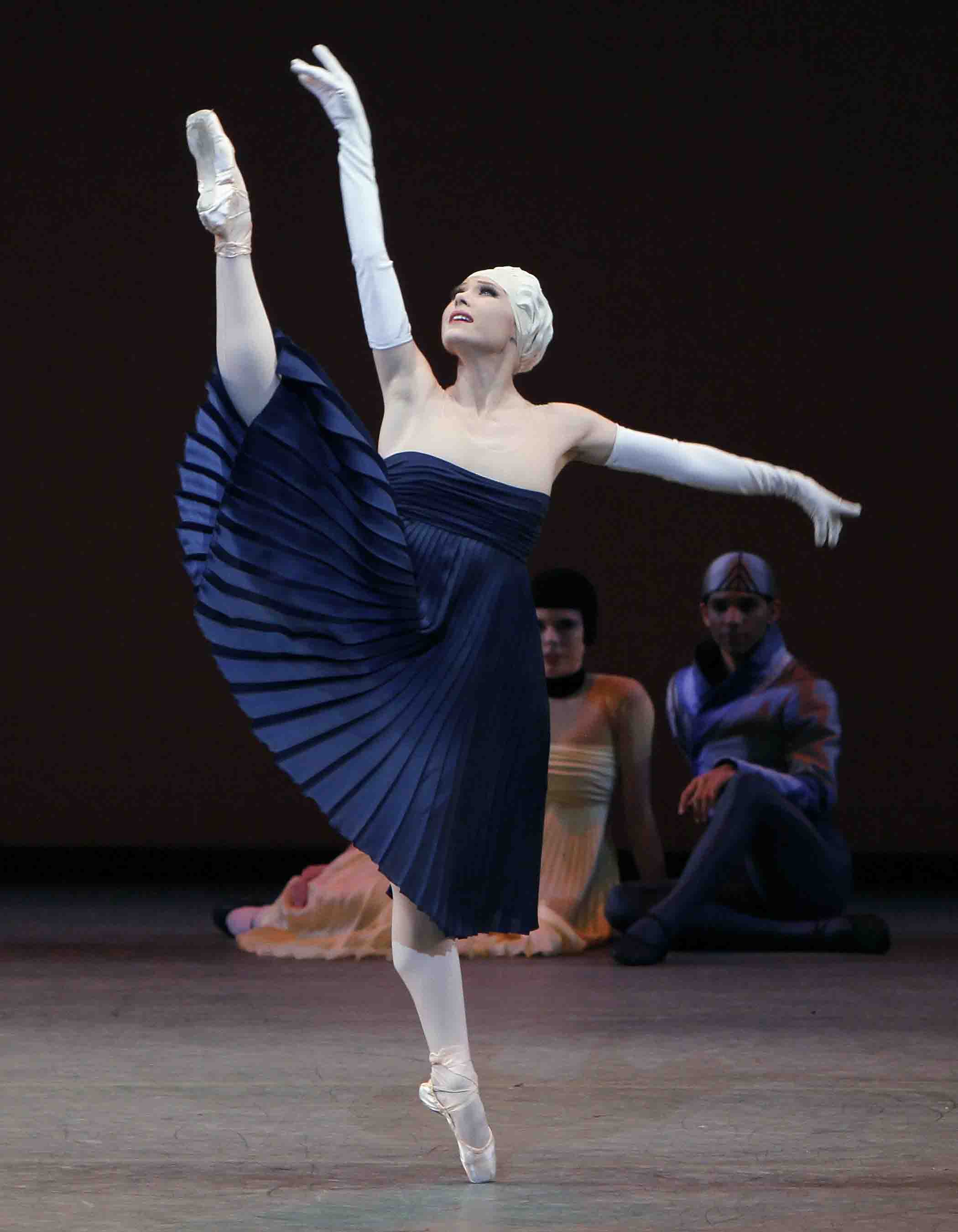
Sara Mearns in Alexei Ratmansky's Namouna, A Grand Divertissement, one of the seven new works in New York City Ballet's "Architecture of Dance" festival
Photo: Paul Kolnik
Almost as if in passing, Ratmansky quotes from every ballet you've ever loved--seen or merely heard about--and no doubt several that flew under your radar. Some of the most obvious references are to: the arabesques voyagées of the corps of wilis in Act II of Giselle (which Ratmansky assigns to the motorcycle-gang octet); the frantic gestures of Gennaro, the hero of Bournonville's Napoli, when he thinks he has allowed his beloved to drown (which Ratmansky gives to a woman); a lexicon of Danish mime gestures, themselves borrowed from France or Russia--"beautiful," "love," et al.; the elegiac dance of the ensemble of swans that opens traditional versions of Swan Lake's Act IV, now heinously omitted from zippy new versions of the ballet because it's thought to slow things down; bits of Balanchine plucked and tweaked from sources as diverse as Apollo, La Sonnambula, and Mozartiana; and even a few signature devices of Paul Taylor's. Ratmansky singles out these moves, wittily shifting their context and purpose, in ways that simultaneously reveal their absurdity (for ballet is essentially both absurd and sublime) and his delight in them.
Blessedly, the scenic investiture of Namoura consists simply of a backdrop onto which Mark Stanley plays light in various colors. (A Santiago Calatrava installation--like those created for five of the season's seven new works--would surely have been a roadblock.) Marc Happel and Rustam Khamdamov designed the costumes. In some instances these are handsome--Mearns's long-skirted navy gown, for instance, gives a luxuriant dimension to the term "accordion-pleated." Elsewhere--especially when it comes to the ladies' thick white "bathing caps," suggesting cresting waves or perhaps a Marcel wave of the Twenties--they are over the top.
I loved Namouna from its first showing at City Ballet's opening night gala, but it was on a second viewing that everything fell into place for me. What had seemed to be the busiest and one of the longest one-act ballets ever made was suddenly fully clear--in its beauties, its wit, and its ability to induce waves of nostalgia, even for things I had never seen firsthand.
© 2010 Tobi Tobias
Sitelines
AJ Ads
 360° Dance Company at DTW offers two socially relevant revivals, Jane Dudley’s solo “Time Is Money” (1932) and Mary Anthony’s “Devil in Massachusetts” (1952) as well as the World Premier of Artistic Director, Martin Lofsnes' "6-1".
360° Dance Company at DTW offers two socially relevant revivals, Jane Dudley’s solo “Time Is Money” (1932) and Mary Anthony’s “Devil in Massachusetts” (1952) as well as the World Premier of Artistic Director, Martin Lofsnes' "6-1".
AJ Blogs
AJBlogCentral | rssculture
Terry Teachout on the arts in New York City
Andrew Taylor on the business of arts & culture
rock culture approximately
Laura Collins-Hughes on arts, culture and coverage
Richard Kessler on arts education
Douglas McLennan's blog
Dalouge Smith advocates for the Arts
Art from the American Outback
Chloe Veltman on how culture will save the world
For immediate release: the arts are marketable
No genre is the new genre
David Jays on theatre and dance
Paul Levy measures the Angles
Judith H. Dobrzynski on Culture
John Rockwell on the arts
innovations and impediments in not-for-profit arts
Jan Herman - arts, media & culture with 'tude
dance
Apollinaire Scherr talks about dance
Tobi Tobias on dance et al...
jazz
Howard Mandel's freelance Urban Improvisation
Focus on New Orleans. Jazz and Other Sounds
Doug Ramsey on Jazz and other matters...
media
Jeff Weinstein's Cultural Mixology
Martha Bayles on Film...
classical music
Fresh ideas on building arts communities
Greg Sandow performs a book-in-progress
Harvey Sachs on music, and various digressions
Bruce Brubaker on all things Piano
Kyle Gann on music after the fact
Greg Sandow on the future of Classical Music
Norman Lebrecht on Shifting Sound Worlds
Joe Horowitz on music
publishing
Jerome Weeks on Books
Scott McLemee on books, ideas & trash-culture ephemera
theatre
Wendy Rosenfield: covering drama, onstage and off
visual
Public Art, Public Space
Regina Hackett takes her Art To Go
John Perreault's art diary
Lee Rosenbaum's Cultural Commentary
